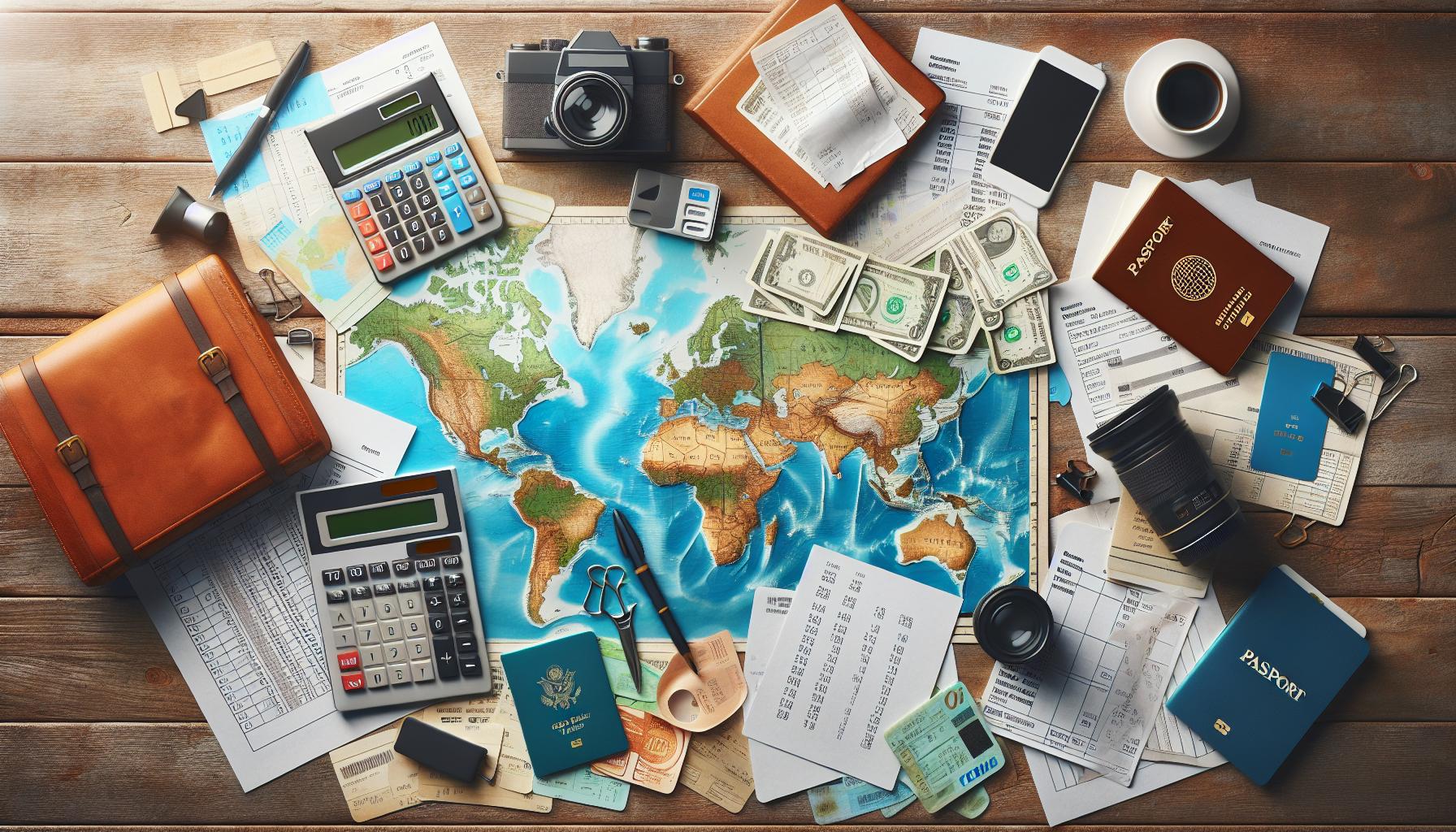Planning a trip without a budget is like jumping out of a plane without a parachute – thrilling but potentially disastrous! A printable travel budget template serves as the perfect financial compass for wanderlusters who want to explore the world without emptying their bank accounts.
Whether it’s a weekend getaway or a month-long adventure across continents travelers need a reliable way to track their expenses. A well-designed travel budget template helps organize everything from accommodation costs and transportation fees to those irresistible souvenir purchases and unexpected gelato cravings. With the right template you’ll never have to worry about running out of money halfway through your dream vacation or coming home to an empty wallet.
Why You Need a Travel Budget Template
A travel budget template organizes financial planning into clear categories. This digital or printable tool breaks down expenses into essential segments: transportation, accommodation, activities, food, emergency funds.
Travel budget templates offer these key advantages:
- Expense Tracking: Records every spending category from flights to local transportation
- Budget Allocation: Distributes available funds across different travel needs
- Overspending Prevention: Monitors daily expenses against preset limits
- Currency Conversion: Calculates costs across different currencies automatically
- Financial Timeline: Maps out payment deadlines for bookings deposits
The organized format prevents common financial pitfalls:
| Travel Expense Category | Average Percentage |
|---|---|
| Transportation | 30-35% |
| Accommodation | 25-30% |
| Food & Drinks | 15-20% |
| Activities | 10-15% |
| Emergency Fund | 5-10% |
A comprehensive template includes specific features:
- Pre-trip expense sections for visas passports insurance
- Daily spending logs for meals souvenirs activities
- Running total calculations to track remaining funds
- Space for recording payment methods due dates
- Currency conversion fields for international travel
Using a travel budget template transforms abstract numbers into actionable plans. This organizational tool eliminates guesswork in financial planning ensures travelers maintain control over their spending throughout their journey.
Key Components of a Travel Budget Planner

A comprehensive travel budget planner includes essential categories that cover all aspects of a trip. These components ensure travelers track expenses effectively while maintaining financial control throughout their journey.
Transportation Costs
Transportation expenses encompass multiple travel segments from departure to return. Local transportation costs include taxi fares, subway tickets, bus passes or rental car fees. International travel costs factor in flights, train tickets or cruise bookings. Additional transportation expenses incorporate airport transfers, fuel charges, parking fees or toll payments. Most travel budgets allocate 30-45% for transportation, with flight costs typically consuming the largest portion.
Accommodation Expenses
Accommodation costs represent a significant portion of any travel budget, typically 20-35% of total expenses. Hotel rates vary based on location, season, star rating or room type. Alternative lodging options include hostels, vacation rentals, guesthouses or camping sites. Extra accommodation expenses cover resort fees, tourism taxes, security deposits or early check-in charges. Booking fees, cancellation policies or upgrade costs also impact the total accommodation budget.
Food and Entertainment
Food and entertainment expenses generally comprise 15-25% of the travel budget. Dining costs include restaurant meals, street food, groceries or snacks. Entertainment expenses encompass attraction tickets, guided tours, museum entries or cultural shows. Activity costs cover adventure sports, spa treatments, shopping or local experiences. Additional expenses include photography permits, equipment rentals or special event tickets.
Emergency Fund Allocation
Emergency fund allocation protects travelers from unexpected situations, requiring 10-15% of the total budget. Medical expenses include travel insurance, emergency care or prescription medications. Unforeseen costs cover lost baggage replacement, flight changes or accommodation rebooking. Emergency communication expenses include international phone calls, internet access or emergency transportation. Additional contingency funds address currency fluctuations, stolen item replacement or extended stay requirements.
Best Free Printable Travel Budget Templates
Several free printable travel budget templates help travelers track expenses effectively during their journeys. These templates come in various formats to accommodate different travel styles preferences.
Basic Travel Planner Template
The Basic Travel Planner Template features essential expense categories in a straightforward, single-page layout. This template includes dedicated sections for transportation costs like flights rental cars trains buses taxis. Expense tracking areas cover accommodations food entertainment shopping activities with pre-formatted cells for daily budgets actual spending. The template displays running totals expense percentages automated calculations to monitor spending patterns. Simple color-coding indicates over-budget under-budget categories making financial tracking intuitive at a glance.
Detailed Vacation Budget Worksheet
The Detailed Vacation Budget Worksheet expands tracking capabilities with comprehensive expense monitoring across multiple pages. This template incorporates pre-trip expenses such as visas insurance gear purchases vaccinations. Daily spending logs feature local currency conversion calculations meal tracking activity costs transportation expenses. Built-in formulas automatically calculate remaining funds percentage allocations across categories. The worksheet includes sections for emergency funds unexpected expenses gift shopping allowing travelers to maintain complete financial oversight throughout their journey.
| Expense Category | Typical Budget Allocation |
|---|---|
| Transportation | 30-45% |
| Accommodation | 20-35% |
| Food/Activities | 15-25% |
| Emergency Fund | 10-15% |
How to Customize Your Travel Budget Template
Travel budget templates offer flexible customization options to match specific travel needs. The following sections outline key ways to personalize templates for maximum effectiveness.
Adding Personal Categories
A travel budget template becomes more effective with personalized expense categories. Common additions include pet care costs while traveling, travel insurance premiums, visa application fees, vaccination expenses. Travelers add specific columns for hobby-related purchases such as photography equipment rentals or sports gear storage. Digital nomads incorporate workspace rental fees, internet packages, coworking memberships. Adventure travelers include categories for equipment rentals, guide services, permits. The template accommodates these additions through expandable sections that maintain automatic calculation formulas intact.
Adjusting for Different Trip Types
Travel budget templates adapt to various journey styles through targeted modifications. Business trips focus on reimbursable expenses like client meetings, networking events, conference fees. Family vacations emphasize categories for child-friendly activities, family-sized accommodations, group tour discounts. Solo backpacking adventures prioritize hostel costs, public transportation passes, flexible meal plans. Weekend getaways concentrate on compact categories covering short-term expenses like parking fees, attraction tickets, quick meals. Each trip type requires distinct category adjustments based on duration, purpose, destination. Digital templates automatically recalculate totals when adding or removing sections specific to each travel style.
Tips for Sticking to Your Travel Budget
Track every expense in real-time using a mobile app or paper template to maintain accurate records.
Research destination costs beforehand:
- Compare accommodation prices across multiple booking platforms
- Check local transportation rates including buses taxis metros
- Look up average meal costs at various dining establishments
- Research entrance fees for attractions museums tours
Set daily spending limits:
- Allocate specific amounts for meals entertainment activities
- Create separate envelopes or digital wallets for each category
- Monitor running totals against preset thresholds
- Transfer unused daily allowances to emergency funds
Use money-saving strategies:
- Book accommodations with kitchen facilities to prepare meals
- Travel during off-peak seasons for better rates
- Purchase transit passes instead of individual tickets
- Join loyalty programs for hotels airlines attractions
- Utilize free walking tours local markets public spaces
Monitor currency exchange rates:
- Exchange money at banks rather than airports or hotels
- Use credit cards with no foreign transaction fees
- Download currency converter apps for quick calculations
- Avoid dynamic currency conversion when paying by card
Create buffer zones:
- Add 15% extra to estimated costs for unexpected expenses
- Keep emergency funds separate from daily spending money
- Store backup payment methods in different locations
- Document refund policies cancelation fees insurance coverage
This structured approach transforms budget tracking from a constraint into a practical tool for maximizing travel experiences while maintaining financial control.
Digital vs. Printable Budget Templates
Digital travel budget templates offer automated calculations through spreadsheet formulas that instantly update totals when expenses change. Mobile accessibility allows travelers to input costs on the go using smartphones or tablets. Cloud storage capabilities ensure budget data remains safe even if devices are lost during travel.
Printable budget templates provide tactile interaction with physical paper, making expense tracking possible without relying on electronic devices or internet connection. Paper templates stay functional in areas with limited connectivity or when devices run out of power. Manual calculations on printed sheets help travelers maintain a closer connection to their spending habits.
Here’s a comparison of key features:
| Feature | Digital Templates | Printable Templates |
|---|---|---|
| Accessibility | Requires device + power | Works anywhere |
| Calculations | Automatic | Manual |
| Sharing | Easy digital sharing | Physical copies needed |
| Editing | Flexible modifications | Limited to paper space |
| Backup | Cloud storage options | Physical copies only |
Digital templates excel at:
- Converting currencies automatically
- Creating spending graphs
- Syncing across multiple devices
- Generating expense reports
- Backing up data securely
Printable templates excel at:
- Working without technology
- Providing immediate visual feedback
- Enabling quick note taking
- Functioning in remote locations
- Maintaining privacy offline
The choice between digital vs printable formats depends on travel destination connectivity access frequency of expense tracking personal comfort with technology. Some travelers combine both methods using printable sheets for daily tracking then transferring data to digital templates for long term record keeping.
Conclusion
A printable travel budget template serves as an indispensable companion for any traveler seeking financial clarity during their adventures. This powerful tool transforms the daunting task of expense management into a straightforward and organized process.
Whether choosing a digital or printable format travelers can confidently track their spending allocate funds appropriately and prepare for unexpected situations. The right template paired with proper planning helps create unforgettable travel experiences without the stress of financial uncertainty.
By implementing these budgeting tools and strategies travelers can focus on what matters most – making memories while exploring the world with peace of mind knowing their finances are under control.




